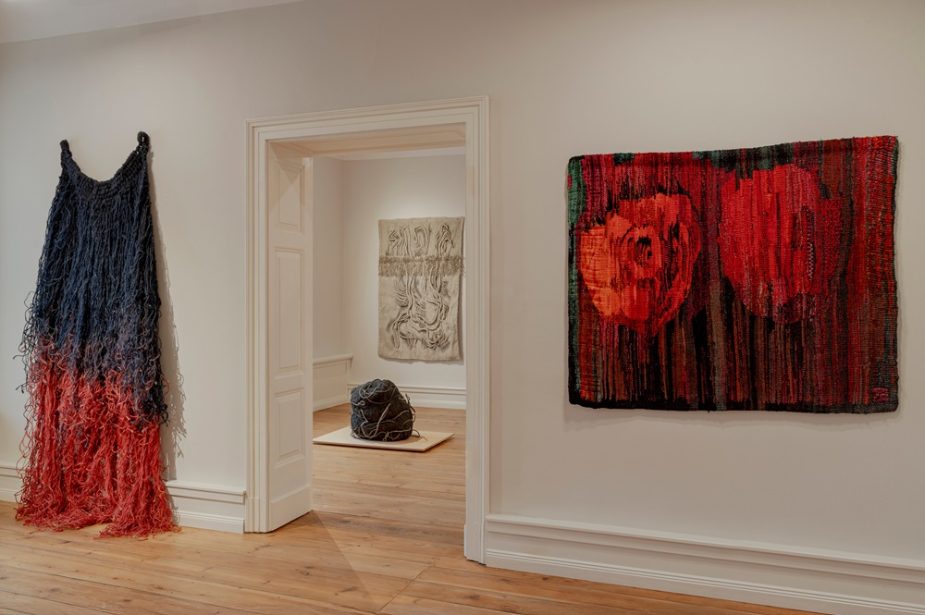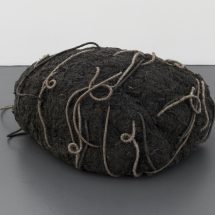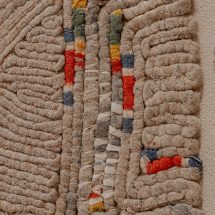COMMON THREADS
Butrymowicz / Jacobi / Jecza / Jeitner / Owidzka / Sadley / Ziman / Żerwe
Curated by Claudia Kudinova
Exhibition opening: 23.10.2024, 6:30 pm
Exhibition duration: 23.10.2024 – 29.11.2024
Artists and artists:
Zofia Butrymowicz / Ritzi Jacobi / Ritzi i Peter Jacobi / Klara Biro Jecza / Christa Jeitner / Jolanta Owidzka / Wojciech Sadley / Magda Ziman / Małgorzata Żerwe
“Fiber art was modernism protected by its process.”
In 1998 the art historian Catherine S. Amidon illustrated a crucial argument for the understanding and contextualization of pioneers of Eastern European textile art. Focusing on the ‘Polish School of Textile Art‘ with one of its most prominent representatives Magdalena Abakanowicz, it allows to draw connections to further – internationally less acclaimed – Polish textile protagonists such as Abakanowicz’s colleagues Jolanta Owidzka (b. 1927, d. 2020), Zofia Butrymowicz (b. 1904, d. 1987) and Wojciech Sadley (b. 1932, d. 2023). In doing so, the argument also opens up perspectives on further Eastern European textile innovators such as the Romanians Ritzi and Peter Jacobi (b. 1941, d. 2022; b. 1935), Klara Biro Jecza (b. 1937, d. 2011) and Magda Ziman (b. 1942, d. 2003) as well as Christa Jeitner (b. 1935), an artist who developed her creative practice in the former GDR outside of state-political settings.
By engaging with the textile medium – that while charged with the notion of a folkloric, decorative craft was simultaneously protected by the very same notion – these artists were able to subvert the postulates of their communist regimes, which were mainly enforced among painting. Thus, the engagement with the thread opened up space for aesthetic intervention and experimentation with modernist abstract tendencies through pictorial instances such as material, technique, form and color. Drawn directly from the textile material as well as the variety of textile techniques – including weaving, stitching or tying – the textile proved to act as a vehicle for a transmedial approach to artistic expression. Departing from this modernist contextualization, the group exhibition traces the eponymous common thread of innovatory approaches to textile art of Eastern Europe. Starting in the 1960s the selected artists enter into a multifaceted dialogue with each other.
While the art historically prominently outlined sculptural dimension of relief-like and plastic art forms is renegotiated in the artistic approaches of Wojciech Sadley, Ritzi and Peter Jacobi or Małgorzata Żerwe (b. 1954), the presentation also aims to draw attention to the graphic and painterly qualities of the textile. The color-intensive, expressive tapestries of Jolanta Owidzka evoke the impression of an immediate painterly gesture, while the figurative references of Zofia Butrymowicz’s tapestries dissolve in what seems to be gradients of liquid paint. However, both positions are drawn from the terms and refinement of the weaving material and technique used for its creation. For artists such as Klara Biro Jecza as well as Ritzi and Peter Jacobi the graphic quality of the line does not only serve as a preliminary step to relief-like textile artworks, but constitutes their composition; as it does vice versa. Therefore Ritzi Jacobi – who later pursues a solo career – ultimately inverts the presumed chronology of a preceding paper sketch, by staging the paper itself prominently as a textile soft drawing. The understanding of the fiber and the thread as means of painting, drawing and sculpting also coins the work of Christa Jeitner, which is additionally reflected in the descriptions of her techniques: Schnürwerk (lacing-work) or Maschinennahtzeichnung (machine-seam-drawing) are only a few of the neologism she creates in order to grasp onto the transmedial dimension of the thread. The inherent quality of the textile to mediate between different spheres of artistic expression as well as different artistic narratives inevitably turns it into a carrier of content and meaning. For Christa Jeitner these are often themes relating to the events of the Shoah; an encounter with the unspeakable that provokes an empathetic and particularly sensory reception. The focus on an immediate, sensory perception is significant to the avant-gardist approach to textile art that – relieved from its folkloric and decorative connotation – is activated in the specific expression of its materiality; an expression that is to be experienced in the group exhibition Common Threads.
Claudia Kudinova, September 2024
Quote: Catherine. S. Amidon: Different Voices with Common Threads: Polish Fiber Art Today, in: The Polish Review, Vol. 43, No. 2, 1998, pp. 195-205, here p. 199.
___________________________
Curator: Claudia Kudinova
Coordination: Karolina Jaworska
Promotion: Maria Majchrowska
Visual identification: Grzegorz Kozak
Realization: Michalczak – Keep Away From Fire
Translation: Karol Waniek, Volkmar Umlauft
Collaboration: Karolina Jara, Weronika Kałuża, Iga Mikuśkiewicz, Valentina Schaiko, Ivan Shpak, Agnieszka Wróblewska













